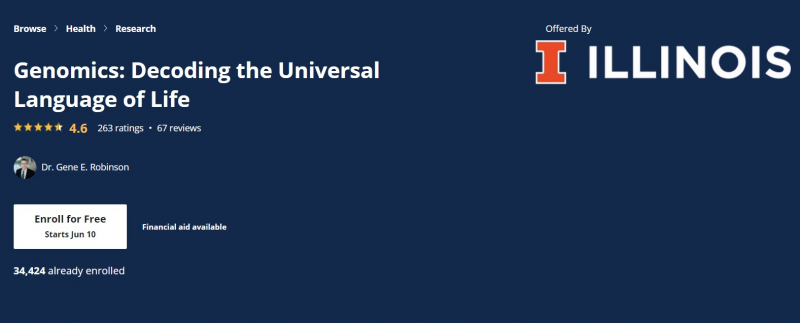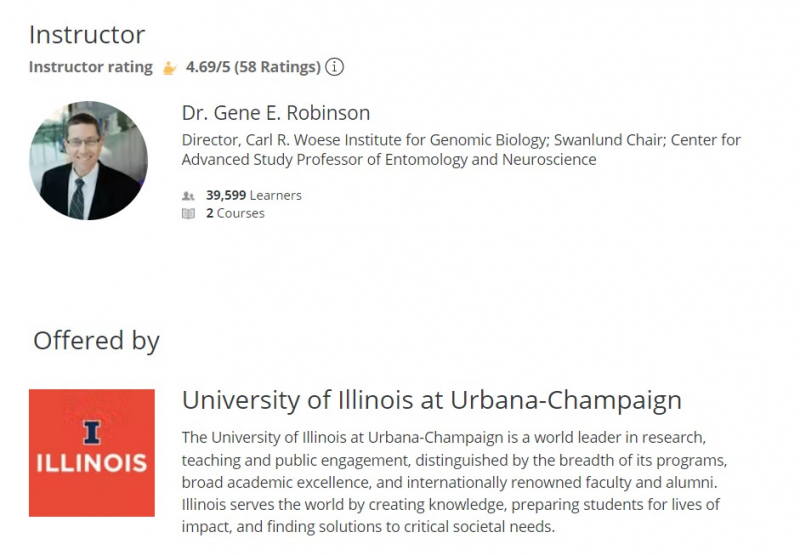Genomics: Decoding the Universal Language of Life

What exactly is a genome? A genome includes all of the information required for a cell to develop, operate, and replicate itself, as well as all of the information required for those cells to join together to become a human, plant, or animal. Genomes include an organism's whole collection of genes as well as the even more minute genetic structures that help govern when and how those genes are employed. Genomes encode the ability to repair a damaged ligament, signs that may anticipate the development of mental disease, the nutritional potential of crops, and even the history of life itself. By completing this course, you will learn how scientists are interpreting the language of genes to generate sustainable food and fuel supplies, better illness treatment and prevention, and safeguard your environment. This course's primary lecturer is Professor Robinson. In addition, each module includes a number of guest professors. These guest teachers come from a variety of disciplines—biology, physics, computer science, and many others—and pursue a variety of research aims, but they all have a common interest in genomic techniques and technology.
Genes, genomes, DNA: these words have slipped into the daily news cycles and the awareness, but what they actually mean often remains unclear. In these lessons, they aim to give you not just the Biology 101 explanation of what a genome is but a real-life perspective on why you already care about genomics—perhaps in ways you didn’t even realize. Are you interested in where your food comes from, what health conditions you are most likely to develop, or what fish will share your aquarium most successfully? Genomes are a key to finding a better answer to these and other everyday questions.
You may have seen DNA visually represented in different ways: a twisted ladder, a tangle of string, an array of sloppy X shapes, a row of letters. But what is DNA actually doing, and how does it relate to genes and the genome? How are scientists able to move from studying the physical structure of the genome to understanding its functionality? This module will help you become more comfortable with these ideas.
Often, they hear about genes only when something goes wrong – when mutations, mistakes made in the DNA sequence, cause a disease like cancer or cystic fibrosis. But what happens inside their cells that leads from a mutation in DNA to the physical symptoms of a disease? Why do some mutations cause positive outcomes or no change at all? To answer these questions, you take a closer look at how information flows from genes, to RNA, to proteins, and to all the physical structures and processes that make up living things.
If all the cells in all the tissues and organs of your bodies have the same genome, how is it that they can look so different? How does a hair cell, a white blood cell, or a brain cell know what to do or where to go? The answer can be found by looking beyond the structure of the genome, into the timing of its activities. Recognizing how the information stored in the genome can be used in flexible ways shows them how living things can develop and change over time. You may have heard of "nature vs. nurture" or the modern day response, "nature AND nurture!" But how does "nurture," the environment, act on the genome? Can the biological effects of experience be passed from one generation to the next? And what does all of this have to do with everyday issues like your physical and mental health? A closer look at two mechanisms that help regulate the activity of genes, epigenetic modifications and transcription factors, provides some answers.
The world is a big and sometimes incomprehensibly complex place. Just as no gene in the genome acts in isolation, no living thing on this planet exists in isolation. In this final module of the course, you explore some of the rich, complicated interactions between living things, their genomes, and the world that surrounds them.
This course offers
- Flexible deadlines
- Shareable Certificate
- 100% online
- Beginner Level
- It takes approximately 36 hours to complete.
- Subtitles: Arabic, French, Portuguese (European), Serbian, Italian, Vietnamese, German, Russian, English, Spanish, Romanian
Coursera rating: 4.6/5
Enroll here: https://www.coursera.org/learn/genomics-research#syllabus










